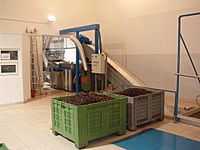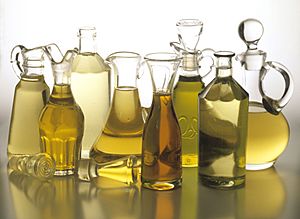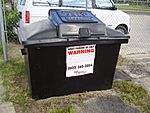Cooking oil facts for kids
Cooking oil is a type of fat that we use to cook food. It can come from plants, animals, or sometimes it's made in a lab. We use it for frying, baking, and other ways of cooking. You can also use it without heat, like in salad dressings or for dipping bread. When used this way, it's often called edible oil.
Most cooking oils are liquid when they are at room temperature. However, some oils, like coconut oil and palm oil, are solid because they contain more saturated fats.
There are many different kinds of cooking oils. Plant-based oils include olive oil, soybean oil, canola oil, corn oil, and peanut oil. Some animal-based oils are butter and lard. You can also add flavors to oil with things like herbs, chillies, or garlic.
Contents
Cooking Oil and Your Health

Eating the right amount and type of fat is important for your health. Experts like the Food and Drug Administration suggest that only a small part of your daily calories should come from saturated fats. They recommend that most of your fat calories should come from healthier fats called polyunsaturated and monounsaturated fats.
Some oils, like coconut oil and palm oil, are higher in saturated fats. Oils that have less saturated fat and more unsaturated fats are generally healthier. These include olive oil, peanut oil, canola oil, and soybean oil.
Health organizations suggest replacing saturated fats with polyunsaturated and monounsaturated fats. For example, olive oil and canola oil are good sources of monounsaturated fats. Soybean oil and sunflower oil are good sources of polyunsaturated fats. Choosing these oils can help lower the risk of heart disease.
If you have a nut allergy, be careful with oils made from nuts, like peanut oil or cashew oil. These can cause allergic reactions.
What are Trans Fats?
Trans fats are different from other fats. They are not needed by your body and are not good for your health. Eating trans fats can increase your risk of coronary heart disease. This happens because they raise "bad" LDL cholesterol and lower "good" HDL cholesterol. Trans fats from partially hydrogenated oils are even more harmful than natural ones.
Many studies show a link between eating a lot of trans fats and heart problems. Health groups like the Food and Drug Administration and the American Heart Association recommend limiting how much trans fat you eat.
Cooking Safely with Oil
When you heat oil, its properties change. An oil that is healthy at room temperature might become less healthy if it gets too hot. So, it's important to choose an oil that can handle the temperature you will be cooking at. This is called an oil's heat tolerance.
For deep-frying, temperatures are usually around 170-190°C (340-375°F). Palm oil has more saturated fats than many other vegetable oils. This means it can handle higher temperatures for deep frying and resists breaking down. Since the early 1900s, palm oil has been used a lot in commercial food because it stays stable when frying or baking at high heat. It also has natural antioxidants.
Here are some oils that are good for high-temperature frying because they have a high smoke point (above 230°C or 446°F):
- Avocado oil
- Mustard oil
- Palm oil
- Peanut oil
- Rice bran oil
- Safflower oil
- Semi-refined sesame oil
- Semi-refined sunflower oil
- Olive oil
Storing Your Cooking Oil
All oils can go bad over time due to heat, light, and air. To keep oil fresh longer, it's often stored with a special gas (like nitrogen) on top to keep air out.
Oils stay good longer in a cool, dry place. They might get thicker in cold storage, but they will become liquid again at room temperature. To protect oils from heat and light, take them out of cold storage only when you need to use them.
Refined oils high in monounsaturated fats, like macadamia oil, can last up to a year. Oils high in polyunsaturated fats, like soybean oil, usually last about six months. Walnut oil has a shorter shelf life, often around 3 months, even if the "best before" date is longer.
Oils high in saturated fats, like avocado oil, last a long time and can be stored at room temperature. This is because they have less polyunsaturated fat, which makes them more stable.
How Oils are Made
Cooking oils are made of different kinds of fatty acids. For frying, oils with more monounsaturated or saturated fats are generally preferred. Oils with a lot of polyunsaturated fats are less ideal for high heat. Oils like almond, macadamia, olive, pecan, pistachio, and some types of safflower and sunflower oils are high in oleic acid, a type of monounsaturated fat.
What is Smoke Point?
The smoke point is the temperature at which an oil starts to smoke continuously. When oil smokes, it means it's burning. This can give your food a burnt taste and reduce the healthy nutrients and plant compounds in the oil. Above the smoke point, there are flash and fire points. The flash point is when oil vapors might briefly catch fire. The fire point is when the oil gets so hot that it produces enough vapors to catch fire and keep burning.
The smoke point of an oil can change. It's usually higher for oils that have been refined, meaning impurities and free fatty acids have been removed. Antioxidants can also increase an oil's smoke point. This is why you might see different smoke points listed for the same oil.
Oils are taken from nuts, seeds, olives, grains, or beans. This can be done using chemicals or by mechanical processes. Expeller pressing is a chemical-free way to get oil using a mechanical press with little heat. Cold-pressed oils are made at low temperatures (usually below 105°C or 221°F). This helps keep natural plant compounds like polyphenols and vitamin E, which affect the oil's color, flavor, smell, and nutrition.
How Cooking Oil is Extracted and Refined

Getting oil out of its source (extraction) and then making it ready for use (refinement) are two different steps. Extraction removes the oil from things like seeds or fruits. Refinement then changes the oil's look, feel, taste, smell, or how long it lasts.
Extraction Methods
There are three main ways to extract oil:
- Chemical solvent extraction: This often uses a chemical called hexane.
- Pressing: This uses a machine called an expeller press or a cold press. Cold pressing uses low temperatures to keep the oil from getting too hot.
- Decanter centrifuge: This machine spins the oil very fast to separate it.
In large factories, they often use a mix of these methods to get as much oil as possible.
Refinement Processes
Cooking oil can be unrefined (meaning it's used as is) or refined. Refinement can involve one or more of these steps:
- Distilling: Heating the oil to evaporate any leftover chemical solvents.
- Degumming: Passing hot water through the oil to remove sticky substances and proteins.
- Neutralization: Treating the oil with chemicals to remove free fatty acids and other unwanted parts.
- Bleaching: Using special clays or carbon to remove unwanted colors, then filtering and drying the oil.
- Dewaxing: Cooling the oil to remove any solids that might form, making it clearer, especially for refrigerated oils.
- Deodorizing: Using hot steam to remove smells or tastes that aren't wanted.
- Adding preservatives: Sometimes chemicals like BHA and BHT are added to help oils last longer, especially if they were processed at high temperatures.
Filtering is another step that removes larger particles, but it doesn't change the oil's chemical state.
Most cooking oils you buy in stores go through many of these refinement steps. This makes sure the oil tastes, smells, and looks the same every time, and lasts longer. Oils sold as "health food" are often unrefined. They might not last as long, but they have been exposed to less heat and fewer chemicals.
What to Do with Used Cooking Oil
It's important to get rid of used cooking oil properly. If you pour oil down the sink or toilet, it can harden in the pipes and cause clogs.
The best way to throw away used oil is to put it in a sealed, non-recyclable container. Then, put that container in your regular trash. You can also put the container of oil in the refrigerator first to make the oil solid, which makes it less messy to throw away.
Recycling Used Oil
Used cooking oil can be recycled! It can be used for animal feed, as fuel, or to make biodiesel, soap, and other industrial products.
In the recycling world, used cooking oil from restaurants is often called recycled vegetable oil (RVO) or waste vegetable oil (WVO). This "yellow grease" can be used to feed farm animals and to make things like soap, makeup, clothes, rubber, and biodiesel fuel.
Besides being turned into biodiesel, used cooking oil can also be used directly in special diesel engines or for heating.
Grease traps are devices that collect fats and oils from kitchen sinks. This stops them from clogging sewer lines. The oil collected in these traps is called "brown grease." Brown grease is usually mixed with food scraps and is not suitable for most re-uses.
Images for kids
See also
 In Spanish: Aceite de cocina para niños
In Spanish: Aceite de cocina para niños





